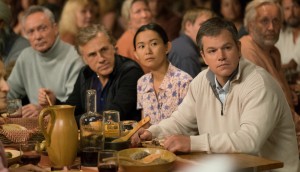My column for the abril 2018 issue of Caiman Cuadernos de Cine. — J.R.
“I personally can’t define the difference between a documentary and a narrative film,” Abbas Kiarostami once said to me, adding that he considered the difference between a good movie and a bad one more important. I would further note that films that blur distinctions between documentary and fiction, including Kiarostami’s, are sometimes better because they do so. This was recently brought home to me when I belatedly discovered that one of my favorite films of 2017, Heinz Emigholz’s Streetscapes [Dialogue], wasn’t a scripted restaging in Uruguay of the filmmaker’s psychoanalysis with its two original participants, as I had naïvely assumed, but a scripted restaging with an American actor and an Argentinian filmmaker — a discovery that made the film even more provocative and impressive.
When I start to reflect on the widely different ways in which documentaries and fictional narratives are shown and marketed, I begin to realize that obfuscating such issues are often marketing decisions, much as obfuscating distinctions between art and politics often turn out to be. As I suggested in my last column, while decrying the public indifference to Harvey Weinstein’s artistic crimes, this is business as usual in current transatlantic discourse — a recognition that Weinstein’s sexual crimes are “commercial” and his artistic crimes “non-commercial”. Making more money for the Donald Trumps and Harvey Weinsteins of the world is still the primary objective.
Consider the title and headline of a recent article in the Financial Times: “Why politics should not go to the cinema” and “Films such as Three Billboards Outside Ebbing, Missouri are increasingly critiqued for their politics — but are we overlooking their art as a result?” Personally, what I find artistically objectionable about Three Billboards are its moral limitations — its cynical catering to its audience’s darker impulses, trafficking in “timely” topics without showing much sustained evidence of a soul or conscience or even simple curiosity about its characters. Treating art and politics as not only separate but also as mutually exclusive categories extends to the current hysteria that has turned an alleged sexual crime of Woody Allen many years ago into a long-overdue and warranted yet still undeveloped questioning of his artistic importance, substituted a Christopher Plummer performance for a Kevin Spacey performance motivated solely by the latter’s allegedly predatory sexual behavior, and implicitly lambasted Alexander Payne for his political agenda in the second half of his Downsizing on the implicit assumption that politics don’t belong in a movie theater apart from a few selected and Oscar-nominated exceptions (e.g., the skewering of hypocritical liberalism in Get Out or the self-satisfied exaltation of sincere liberalism in The Post and The Shape of Water). This is also why Kiarostami’s final feature, 24 Frames, is more apt to be ignored as a documentary than praised as fiction — and why Streetscapes [Dialogue], failing to correspond to any market category, gets overlooked.






